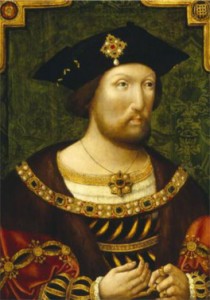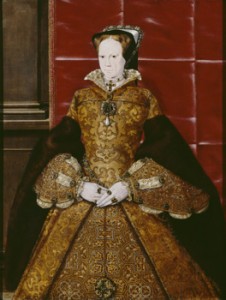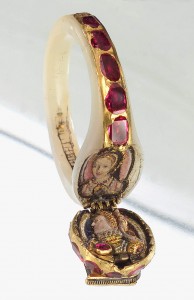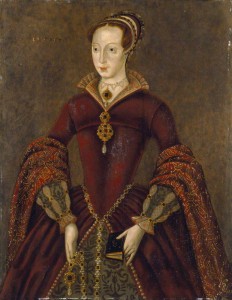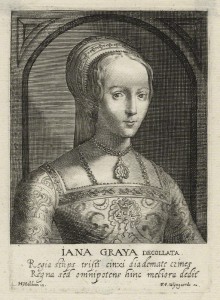‘The Real Tudors: Kings & Queens Rediscovered’ opened at the National Portrait Gallery on 12th September 2014 and runs until 1st March 2015.
This free display is in the usual Tudor Galleries on the third floor of the NPG. Each Tudor monarch has their own section, starting with Henry VII and Henry VIII in Room 1, Edward VI, Mary I and Elizabeth I in Room 2 and Lady Jane Grey in Room 3.
Apart from seeing the Lady Jane ‘Streatham’ portrait back on display, the most fascinating objects in the exhibition for me, were the items that belonged to each Tudor monarch. It was great to see the Elizabeth locket ring again, to see Mary I’s Prayer book and to stand face to face with Henry VII.
As the gallery was quite crowded, I will have to wait for my next visit to read all the analysis of the paintings.
All italics are © NPG.
Will of Henry VII
The Henry VII section consists of:
1 portrait
Book of Hours belonging to Henry VII
Funeral effigy of Henry VII
Book of Hours belonging to Henry VII
c.1500
Ink and pigment on vellum
‘This book was given by Henry VII to his daughter Margaret before she left England in order to marry King James IV of Scotland. He inscribed it to her with the note, ‘Remember your king and loving Father in your prayers, Henry, King.’
Funeral effigy of Henry VII
Attributed to Pietro Torrigiano
Painted plaster and wood 1509
The head from the funeral effigy of Henry VII, was ‘modelled in plaster from the dead king’s face.’
John Skelton’s poem at Henry VIII’s coronation
The Henry VIII section consists of:
6 portraits
Henry VIII’s rosary
The portraits of Henry include ‘one of the earliest surviving portraits of Henry VIII.’
Henry VIII’s rosary
Carved boxwood 1509-27
‘This delicately carved rosary (a string of prayer beads) bears the Royal Arms of England and the letters ‘he8’ and ‘KA’ on the largest bead.’
Sir Richard Morison at Edward VI’s death
The Edward VI section consists of:
6 portraits
A page from Edward VI’s Chronicle
‘On this page Edward describes the moment at which he learnt of Henry VIII’s death and his own accession to the throne.’
Bishop John White at Mary I’s funeral
The Mary I section consists of:
3 portraits + 1 miniature
1 miniature of Philip II
The Queen Mary Book of Prayers
The portraits include the Hans Eworth portrait of Mary.
The Queen Mary Book of Prayers
Illuminated manuscript on vellum c.1554
Unknown artist
‘ These pages are from a manuscript containing instructions for two ceremonies that were usually performed by the monarch on Good Friday.’
Verse praising Elizabth I set to music by John Dowland
The Elizabeth I section consists of:
7 portraits
3 miniatures
Locket ring
The miniatures include a coronation miniature of ‘Elizabeth I by an unknown English artist. Gouache on vellum laid on card, late sixteenth century.
Locket ring
Mother of pearl hoop, rubies, diamonds and enamel
c.1575
‘This exquisite ring opens to reveal two portraits beneath the diamond E: one of Elizabeth in profile, and the other of a woman in a French hood, who is probably Anne Boleyn.’
Lady Jane Grey
The Lady Jane Grey section consists of:
1 portrait
1 engraving
The portrait of Lady Jane is labeled as:
Lady Jane Grey
By an unknown artist
Oil on panel, late sixteenth century
‘Lady Jane Grey was named as heir to the throne by her cousin Edward VI: however, she was imprisoned after only nine days’ rule when Mary successfully asserted her right to the crown. Highly educated and devoutly Protestant, it was only during Elizabeth’s reign that she became more widely known. This fuelled an interest in her portraiture and portraits such as this example were created to mark her place for an Elizabethan audience. However, no lifetime portraits of Jane appear to survive and it is possible that none were ever painted.
By 1620, one image had gained credence as a lifetime portrait and was used as the basis for an engraving. However, the sitter in this image wears a jewel that is very similar to one that belonged to Katherine Parr, and may be Henry VIII’s sixth queen.’
Magdalena and Willem de Passe’s engraving of Lady Jane Grey from Henry Holland’s Heroologia Anglica
Read more about the exhibition at National Portrait Gallery – The Real Tudors: Kings and Queens Rediscovered .
The other Tudor portrait usually on display in the Tudor Galleries
Portraits of Anne Boleyn, Richard III and Catherine Parr have been moved to Room 4. As the light in Room 4 is much better than in the Tudor galleries, you can really appreciate the colours on the Catherine Parr ‘Master John’ portrait.
You can buy the exhibition catalogue from the National Portrait Gallery shop.
The Real Tudors: Kings and Queens Rediscovered by Tarnya Cooper and Charlotte Bolland.

